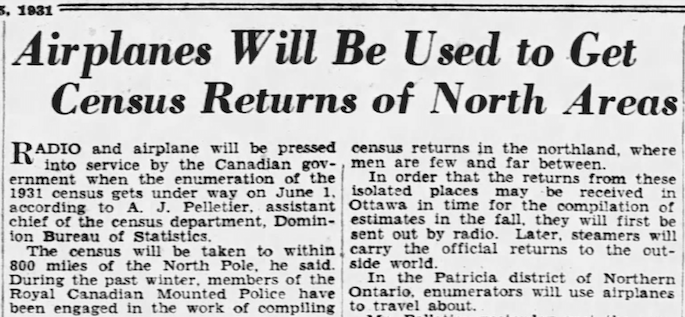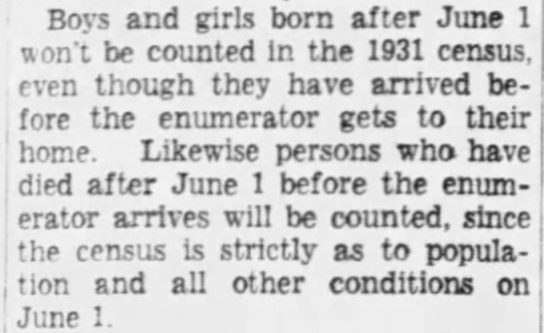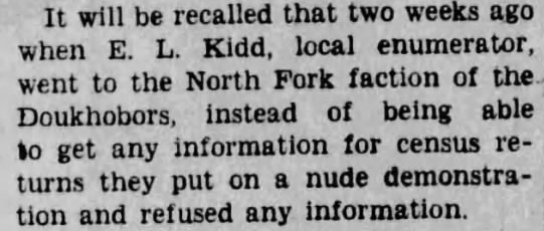On June 1, 2023, the Canadian government will release the digitized records of the 1931 Census of Canada. This highly anticipated event will reveal a snapshot of life for more than 10 million people living in Canada then. Canadian law dictates that census records be kept private for 92 years, but following the release, nearly 235,000 images will be available to browse on the Library and Archives Canada (LAC) website. After the initial release of these digitized records, LAC will partner with Ancestry® and FamilySearch International to read the images using Ancestry’s® state-of-the-art handwriting technology and check the index for accuracy. These collaborative efforts will create an advanced searchable database of records of Canadian residents.
The 1931 Census was Canada’s 7th census (though earlier colonial and regional censuses dated back as early as 1666). The first Census of Canada was enumerated in 1871 and continued every ten years thereafter. On June 1, 1931, an estimated 15,000 enumerators went to work. Canada stretches across 3.8 million square miles, so this was no easy task. Members of the Royal Canadian Mounted Police were enlisted as enumerators in more isolated parts to the north, compiling census questionnaires to within 800 miles of the North Pole. For the first time, census officials didn’t need to wait for those results to arrive via ship. Instead, they sent the tallies using radio transmission or airplanes, and the official returns arrived sometime later via steamship.
The 1931 Census included questions with more than 40 fields of personal information. The population schedule aimed to count every person living in Canada, with one exception. Babies born after June 1, 1931, but before the enumerator arrived at the door, were not counted.
In addition to the population schedule, the 1931 Census contained five additional schedules that gathered information on 1- Agriculture; 2- Livestock; 3- Merchandising and service establishments; 4- The blind, deaf, and mute; and 5- Institutions (including penal institutions, hospitals, mental health hospitals, and sanitoriums).
Most citizens cooperated with enumerators, though there were exceptions. Some farmers complained about how long it took to answer questions on the agriculture schedule and hid from enumerators. A few others refused to answer questions about their earnings and were threatened with prosecution. One religious group presented a big challenge for enumerators.
The Doukhobors, a group of Russian dissenters whose rejection of the Russian Orthodox Church brought them to Canada, created a ruckus for census officials. A small Doukhobor splinter group, the Sons of Freedom, rejected Canadian government authority. So when census enumerators came knocking, they refused to answer and tried to scare away enumerators with nude protest parades or by supplying farcical answers to questions. Authorities issued arrest warrants and eventually imprisoned some for refusing to cooperate.
Canadian newspapers provide vivid accounts of efforts made to conduct the 1931 Census of Canada accurately. To read more historical newspaper stories related to the 1931 Census of Canada and to search our Canadian papers, visit Newspapers.com™ today.





Thank you for this update. Maybe I’ll be able to locate my great uncle who, after coning back from WW1, dropped out of sight.
Ohhh. I’ve got a great uncle like that too. The black sheep of the family – he never married, never owned property, and spent a large part of his life working in logging camps in BC, or as a prospector in northern ON. Because he was a WWI veteran, I lucked out when I found his medical records at Ste Anne’s veteran hospital near Montreal. It answered many questions about where he had been after WWI.
According to Ancestry and his CEF Personnel Files, my granduncle Jesse left the states to join the Canadian Over-Seas Expeditionary Force on the 6th of February, 1916. This military file was housed in Ancestry and it included his military and medical information (some of it is written in French). Then, he married a lady from Great Britain on 28 Oct 1919 at Prince George, BC.
That was the last bit of info I have on him. Did he stay in Canada? He, too, was a logger. He hasn’t shown up in 1920, 1930, 1940, or 1950 US Census. I am so curious. Also, I don’t like having relatives without a death date.
Good luck!!
Did you try the British Columbia archives? Check the genealogy section. This holding has death, marriage and birth records, some of which are digitized.
No I haven’t. Thank you for the tip.
When will the 1931 Canada Census be available for searching and will it be free?
On June 1, 2023, the Canadian government will release the digitized records of the 1931 Census of Canada. This highly anticipated event will reveal a snapshot of life for more than 10 million people living in Canada then. Canadian law dictates that census records be kept private for 92 years, but following the release, nearly 235,000 images will be available to browse on the Library and Archives Canada (LAC) website.
That’s in the first paragraph of the article.
did you see this reply to your post?? – Beverly – please email me at michelle.purcell@sympatico.ca with Jesse’s full name and birthdate. I’ll see what I can find on him. I’m an Archivist / Librarian in Ottawa – and would love to see if I can help you find any more info on him.
The last of the to-list is to make it available for free. No timeframe.
https://library-archives.canada.ca/eng/corporate/website-updates/pages/census-1931.aspx
Great news!
Great news to finally have the 1931 census revealed
Beverly – please email me at michelle.purcell@sympatico.ca with Jesse’s full name and birthdate. I’ll see what I can find on him. I’m an Archivist / Librarian in Ottawa – and would love to see if I can help you find any more info on him.
Email sent. Thank you very much.
I found out my great great grandparents were married in Canada then move to new York! Any info I can find more would be very cool!
Hopefully I can find information on both sides of my family before they immigrated to the states, So cool.
Looking forward to seeing the 1931 census records.
My maternal grandparents immigrated to Canada from Denmark in 1927 and my grandmother desperately wanted to go back to her beautiful homeland. But then the babies came, including my mother who was a twin and then the depression so they could not afford to save up the funds needed for fare for a family of 5.
I always wondered about this because in 1930 my paternal grandparents along with my 5 year old father travelled from Alberta back to Italy for an extended 10 month holiday. How is it that they could afford a grand holiday (even sailing back to Canada on the Empress of Australia which was known as a beautiful and luxurious ship) but my mother’s family could not afford to go back home?
I managed to find employment records from for my paternal grandfather through the University of Calgary Archives and was stunned to find out how much money he made working in the coal mine in Cadomin. In 1928 he made $4,700!! Almost $400 per month plus housing for the family was provided.
The 1931 census includes wages for the past 12 months and I was able to find my maternal grandfather’s information – for that year he made $1,050 and paid $11 month for a rented home, leaving the family with $75/month. That information provided on the census was very helpful in understanding why the family could not go back to Denmark and how they ended up staying in Canada.
And even though I already knew where my grandparents lived in Canada and when they arrived it was pretty cool to see them officially counted in a Canadian census :o)
Maybe you can help me with a question –
I was able to find the District and Sub-Districts for my family living in Northern Ontario and on Manitoulin Island, but I have no no luck at all finding which district and sub-district the town of Cadomin, Alberta was located in 1931.
Today Cadomin is listed to be in the “Yellowhead” district but there was no district with that name in 1931 and since the area is so remote I am having to look through areas listed as
“Townships 47, 48 and 49 in ranges 25, 26, 27 and 28, west of the fifth meridian, township 50 in ranges 26 and 27, west of the fifth meridian, and township 47 in rage 1, west of the sixth meridian, all lying east of the Athabaska River and within municipality”
I do believe that Cadomin is in the sixth meridian but it could be the fifth.
But it is proving to be an impossible search for me.
Were you able to find them in a 1921 census in the same community? if yes, the sub district may have remained the same.
I found it!!
I started scrolling through and realized that each mining town was listed separately so I started looking for only “coal miners” listed under work, that way I could go through each sub-district very quickly.
So Cadomin is listed under Peace River South –
0054 Township 46 in ranges 23 and 24, west of the fifth meridian.
Says “Cadomin” right at the top of the papers but the town name is not added to the official designation.
Your perseverance paid off!
No, the family was not in Canada in that time period.
Any research just tells me that Cadomin is in Yellowhead area 14.
I’ve tried looking through all districts “14” (since there is no Yellowhead) in the whole province but with no luck.
As you probably know names are not in alphabetical order so every page has to be searched!